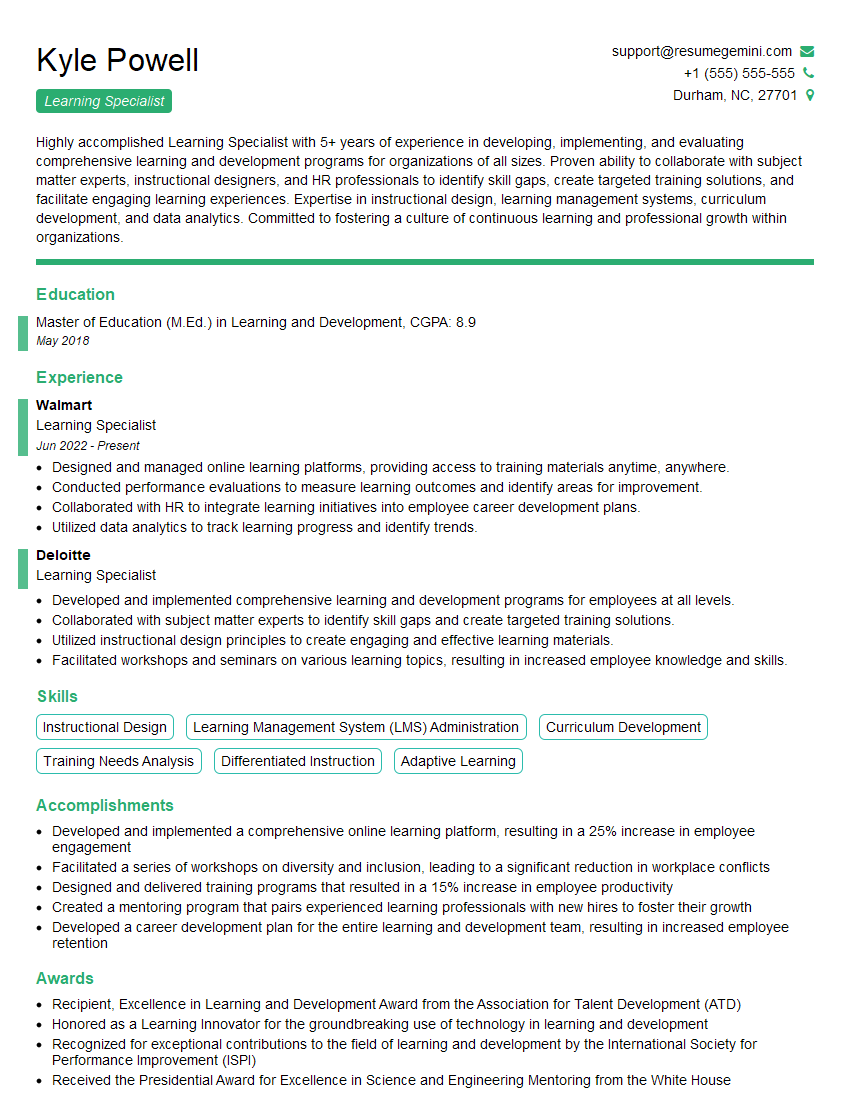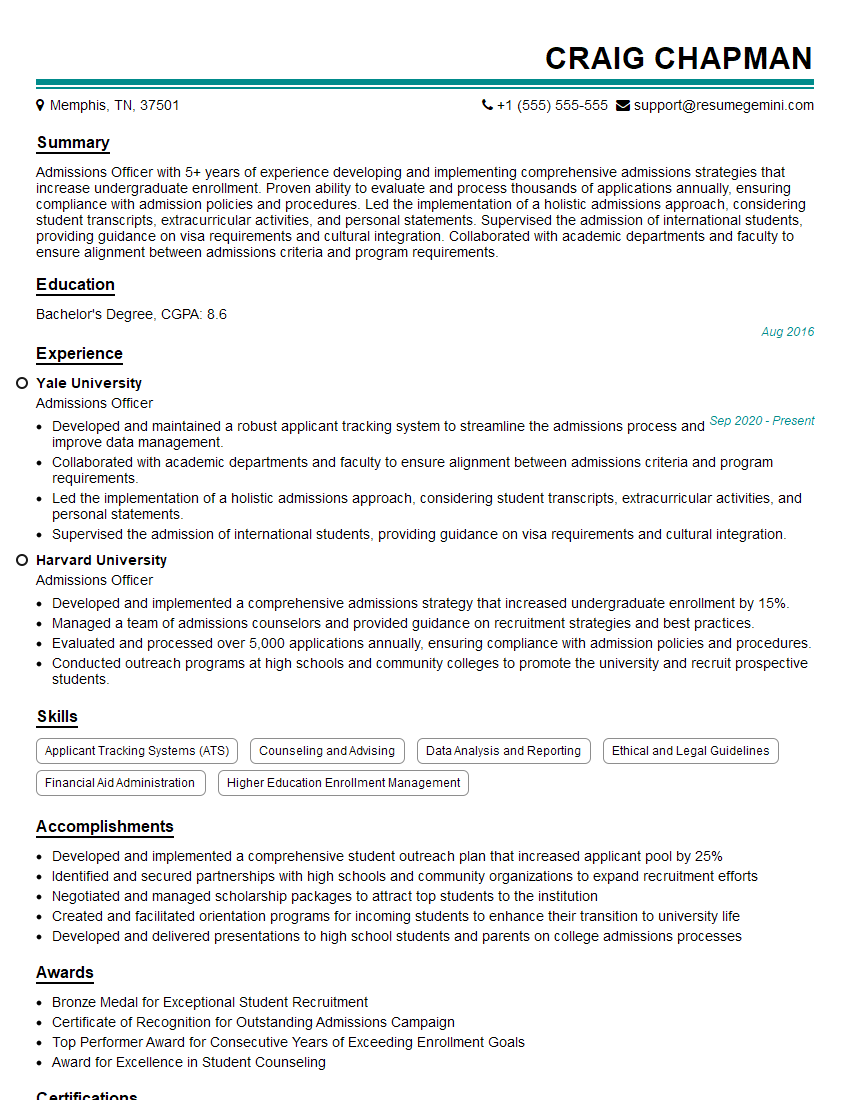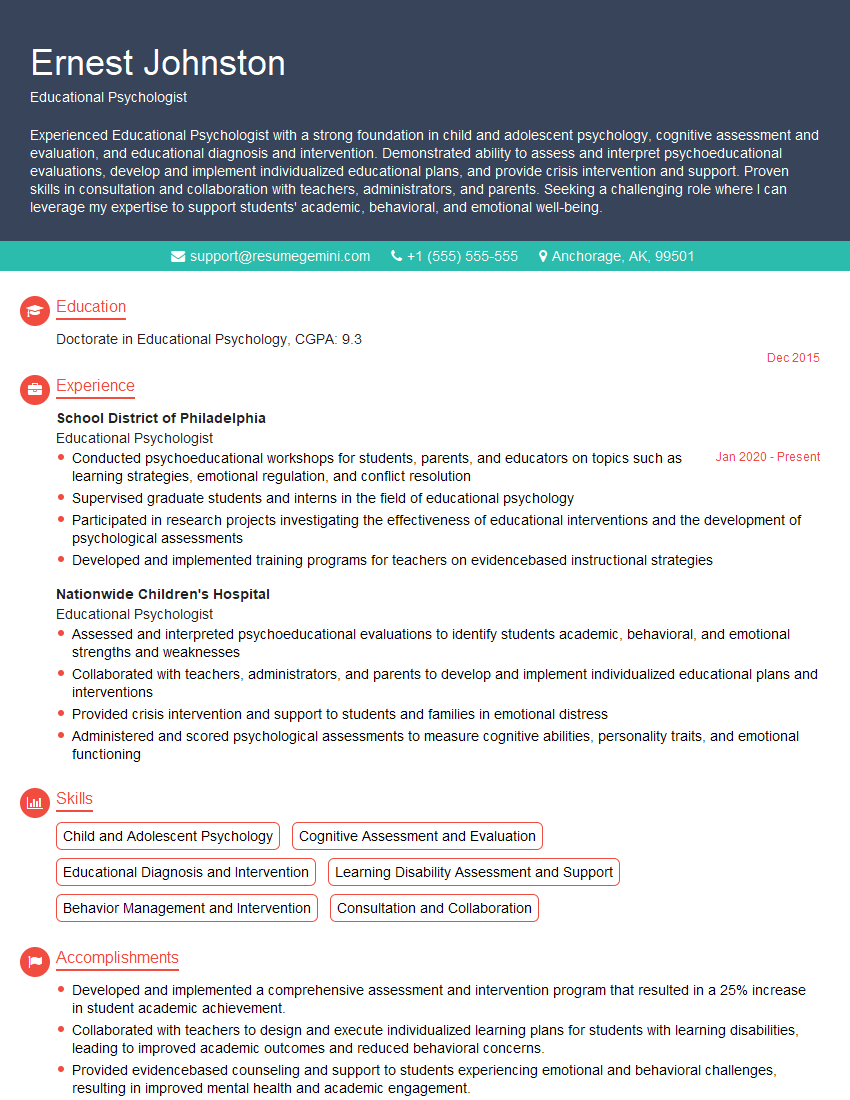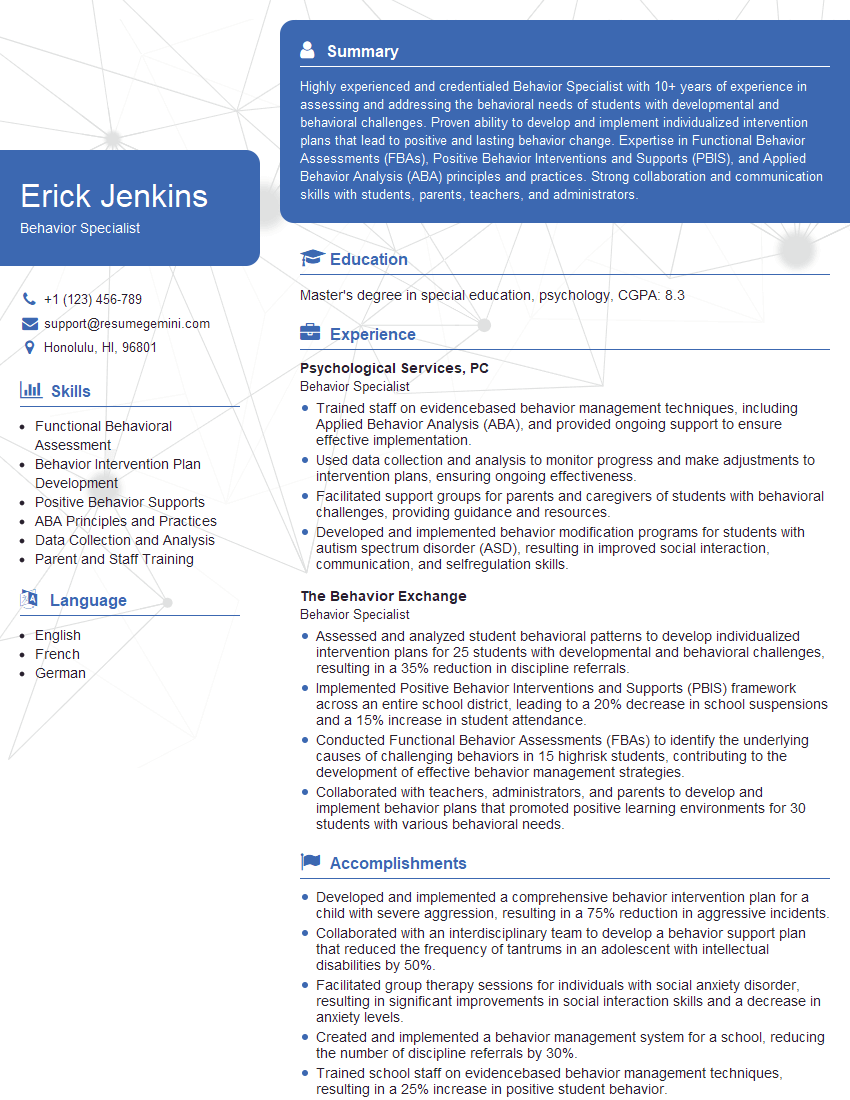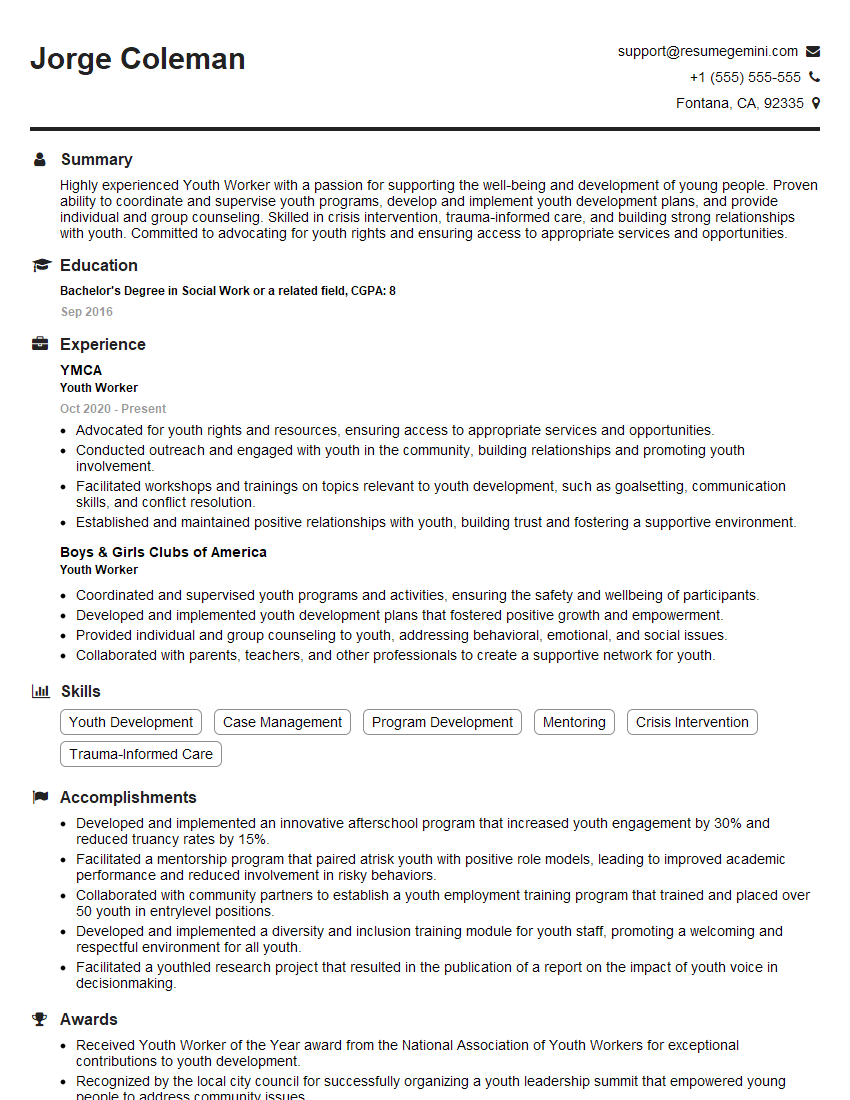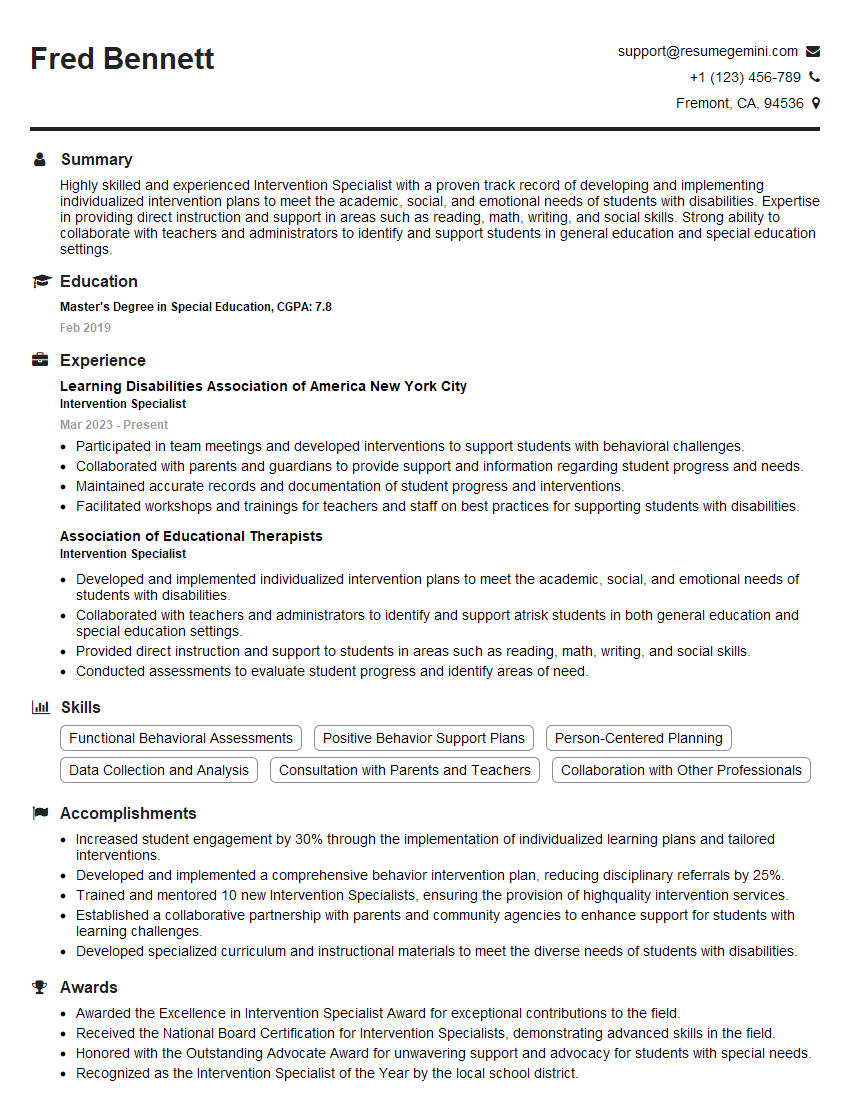The right preparation can turn an interview into an opportunity to showcase your expertise. This guide to Building Rapport with Students interview questions is your ultimate resource, providing key insights and tips to help you ace your responses and stand out as a top candidate.
Questions Asked in Building Rapport with Students Interview
Q 1. Describe your approach to establishing a positive learning environment.
Creating a positive learning environment is crucial for student success. My approach is multifaceted, focusing on building a sense of community, respect, and inclusivity. This involves establishing clear expectations and routines from day one, fostering a culture of open communication where students feel comfortable sharing ideas and concerns, and celebrating both individual and collective achievements.
- Clear Expectations: I clearly communicate my classroom rules and procedures, explaining the rationale behind them. This fosters a sense of shared understanding and reduces potential conflict.
- Community Building: I incorporate icebreaker activities, group projects, and collaborative learning strategies to promote teamwork and build relationships among students. This helps create a supportive atmosphere where everyone feels valued.
- Positive Reinforcement: I focus on positive reinforcement, praising effort and progress, rather than solely focusing on grades. This encourages a growth mindset and builds confidence.
- Open Communication: I create opportunities for regular feedback, both from me to the students and from the students to me. This allows me to address any concerns promptly and adjust my teaching accordingly.
For example, I’ve used a ‘class charter’ where students collaboratively develop rules for respectful interaction, ownership of their learning, and classroom procedures. This creates a sense of shared responsibility for the classroom climate.
Q 2. How do you adapt your communication style to meet the diverse needs of students?
Adapting my communication style to diverse student needs is paramount. I recognize that students learn and process information differently, and I employ a variety of strategies to ensure inclusivity and effective communication. This includes differentiating my teaching methods, considering learning styles, and being mindful of cultural differences.
- Differentiated Instruction: I offer various learning activities catering to visual, auditory, and kinesthetic learners. This might involve using visual aids, interactive discussions, or hands-on projects.
- Multilingual Support: For students with limited English proficiency, I use visual aids, simplified language, and provide access to translation tools. I also collaborate with ESL specialists when needed.
- Individualized Attention: I try to get to know each student’s learning preferences and communication styles. Some students thrive in group discussions, while others prefer one-on-one interactions. I adjust accordingly.
- Cultural Sensitivity: I demonstrate cultural awareness and sensitivity in my interactions, respecting diverse communication styles, and avoiding potentially insensitive language or gestures.
For instance, I might use visual organizers for students who are visual learners or provide extended time for students who require it for written assignments.
Q 3. Explain your strategy for identifying and addressing students’ learning challenges.
Identifying and addressing students’ learning challenges requires a proactive and multi-pronged approach. This involves regular formative assessment, observation, and open communication with students.
- Formative Assessment: I use various formative assessment methods, such as quizzes, exit tickets, and informal observations to monitor student understanding throughout the learning process.
- Observation: I carefully observe students during lessons, paying attention to their engagement levels, participation, and any signs of struggle.
- Student-Teacher Conversations: I maintain open communication channels, encouraging students to share their challenges and concerns. I foster a safe space for them to express themselves honestly.
- Collaboration with Parents/Guardians: When necessary, I collaborate with parents or guardians to provide a comprehensive support system for students.
- Referral to Support Services: If a student’s challenges persist despite interventions, I refer them to appropriate school support services, such as special education or counseling.
For example, if I notice a student consistently struggling with a particular concept, I might provide additional one-on-one support, offer alternative learning materials, or adjust the pacing of the curriculum.
Q 4. How do you build trust and rapport with students from diverse backgrounds?
Building trust and rapport with students from diverse backgrounds requires genuine empathy, cultural sensitivity, and a commitment to creating an inclusive classroom. This involves active listening, showing genuine interest in their experiences, and celebrating their unique perspectives.
- Active Listening: I actively listen to students’ perspectives and experiences, acknowledging their individuality and validating their feelings.
- Cultural Awareness: I demonstrate an understanding and respect for different cultural norms, values, and communication styles.
- Inclusive Curriculum: I incorporate diverse voices and perspectives into the curriculum, ensuring that all students feel represented and valued.
- Building Relationships: I take the time to get to know students individually, learning about their interests, backgrounds, and aspirations. This helps build a foundation of mutual respect and trust.
For example, learning about a student’s cultural background or family traditions can help me better understand their perspectives and create a more inclusive classroom environment. I might incorporate elements of their culture into classroom discussions or projects.
Q 5. Share an example of a time you successfully de-escalated a challenging student interaction.
A student, frustrated by a challenging assignment, became disruptive in class. Instead of reacting negatively, I approached him calmly and privately. I acknowledged his frustration, validating his feelings by saying, “I can see you’re really struggling with this, and that’s okay. It’s a tough assignment.” Then, I actively listened to his concerns, asking clarifying questions about what specifically was causing him difficulty. Once I understood the root of his frustration (a misunderstanding of the instructions), I offered clear, concise explanations and broke the assignment into smaller, manageable steps. We collaboratively created a plan to tackle the task, and his demeanor shifted from anger to focused engagement. The key was empathy, understanding, and providing him with the support he needed to succeed.
Q 6. Describe a situation where you had to modify your teaching approach to better connect with a specific student.
One student was struggling to engage with traditional lecture-based lessons. Observations revealed she was a highly kinesthetic learner who thrived on hands-on activities. I modified my teaching approach by incorporating more interactive elements, such as group projects, role-playing, and hands-on experiments related to the lecture material. This allowed her to actively participate, apply her knowledge, and develop a deeper understanding of the concepts. Her grades improved significantly, and her engagement in the classroom increased dramatically. This highlighted the importance of understanding diverse learning styles and adapting teaching strategies accordingly.
Q 7. How do you handle conflicts or disagreements with students?
Handling conflicts or disagreements with students requires a calm, respectful approach focused on problem-solving and understanding the underlying issues. I aim to create a safe space for open and honest communication where students feel comfortable expressing their viewpoints.
- Active Listening: I actively listen to both my own perspective and the student’s, ensuring that I understand both sides of the issue.
- Empathy: I show empathy and understanding, validating the student’s feelings even if I don’t agree with their actions.
- Collaborative Problem-Solving: I work collaboratively with the student to find mutually agreeable solutions. This may involve brainstorming different options and selecting the best course of action.
- Fairness and Consistency: I maintain fairness and consistency in my interactions, ensuring that all students are treated with respect and dignity.
- Seeking Mediation: In cases where conflict resolution is challenging, I seek the guidance of a mentor or school counselor.
For example, if two students are arguing, I’d facilitate a conversation where each student explains their perspective, helping them to understand each other’s points of view and find a resolution. If needed, I would involve parents or guardians and school administration to ensure a fair and just outcome.
Q 8. What techniques do you use to encourage student participation and engagement?
Encouraging student participation and engagement is crucial for effective learning. My approach is multifaceted, focusing on creating a safe and inclusive environment where students feel comfortable sharing their ideas. I employ several key techniques:
- Varied Instructional Strategies: I avoid monotonous lectures. Instead, I incorporate activities like group discussions, think-pair-share exercises, debates, and interactive games. For example, in a history class, a debate on the causes of World War I can spark lively participation and deeper understanding.
- Creating Authentic Learning Experiences: I connect classroom learning to real-world scenarios. For instance, in a science class, students might design and conduct experiments related to environmental issues, making the learning relevant and engaging.
- Positive Reinforcement and Encouragement: I praise effort and participation, focusing on progress rather than just results. A simple ‘I appreciate your insightful contribution’ can go a long way.
- Open-ended Questions: I encourage critical thinking by asking open-ended questions that don’t have simple yes/no answers. This allows students to express their thoughts and perspectives more freely.
- Student Choice and Voice: I allow students some choice in assignments or projects. This gives them ownership and increases their motivation.
Ultimately, fostering a positive and supportive classroom culture is key. When students feel valued and respected, they’re more likely to participate actively.
Q 9. How do you provide constructive feedback to students without discouraging them?
Providing constructive feedback is an art. My goal is to help students learn and grow, not to discourage them. I follow these principles:
- Focus on Specific Behaviors: Instead of general comments like ‘good job,’ I offer specific feedback on what the student did well and what could be improved. For example, ‘Your essay’s introduction was engaging, but the conclusion could benefit from a stronger summary statement.’
- Balance Positive and Negative Feedback: I always start with positive comments to build confidence before addressing areas needing improvement. This sandwich approach makes the criticism more palatable.
- Offer Actionable Suggestions: My feedback isn’t just about pointing out errors; it’s about offering concrete steps for improvement. For example, ‘To improve your organization, try using a topic sentence for each paragraph.’
- Use a Supportive Tone: I maintain a positive and encouraging tone, emphasizing growth and learning. I avoid accusatory language.
- Provide Opportunities for Revision: I give students a chance to revise their work based on the feedback. This demonstrates my belief in their ability to improve.
Remember, feedback is a process, not a single event. Regular, constructive feedback fosters a culture of learning and growth.
Q 10. How do you foster a sense of community and belonging in your classroom?
Building a sense of community and belonging is essential for student success. I create a classroom where every student feels valued and respected. My strategies include:
- Icebreaker Activities: Starting the year with fun icebreaker activities helps students get to know each other and build relationships.
- Collaborative Projects: Group projects encourage teamwork and allow students to learn from each other.
- Classroom Norms and Expectations: Establishing clear classroom rules collaboratively with students creates a sense of ownership and shared responsibility.
- Celebrating Diversity: I create a classroom that values and celebrates the diversity of backgrounds, perspectives, and learning styles among my students. This involves actively incorporating diverse voices and learning materials.
- Building Relationships: I make an effort to get to know my students individually, learning about their interests and aspirations. This helps me build rapport and create a more personal learning environment.
Ultimately, a strong sense of community fosters a supportive and inclusive environment where every student feels safe to take risks and learn.
Q 11. Explain your understanding of different learning styles and how you cater to them.
Understanding different learning styles is paramount to effective teaching. I recognize that students learn in various ways, including visual, auditory, kinesthetic, and reading/writing preferences. I cater to these styles by:
- Visual Learners: Using diagrams, charts, videos, and other visual aids.
- Auditory Learners: Incorporating discussions, lectures, and audio recordings.
- Kinesthetic Learners: Including hands-on activities, experiments, and movement breaks.
- Reading/Writing Learners: Providing opportunities for reading, writing, and research.
- Differentiated Instruction: I offer a variety of learning activities and resources to address different learning preferences and needs. For instance, I might provide both written and verbal instructions for a task, or offer choice in project formats.
Adapting my teaching to cater to different learning styles ensures that every student has the opportunity to succeed.
Q 12. How do you use technology to enhance student engagement and rapport?
Technology plays a significant role in enhancing student engagement and rapport. I use technology in several ways:
- Interactive Whiteboards: To make lessons more dynamic and engaging.
- Educational Apps and Software: To provide supplemental learning opportunities and personalized practice.
- Online Collaboration Tools: Such as Google Classroom or Microsoft Teams, to facilitate communication, collaboration, and feedback.
- Educational Videos and Simulations: To illustrate complex concepts and make learning more accessible.
- Student Response Systems: To gauge student understanding and encourage participation in real-time.
However, I carefully curate the technology I use, ensuring it aligns with learning objectives and avoids becoming a distraction. Technology should augment, not replace, effective teaching practices.
Q 13. Describe your process for identifying students who may need additional support.
Identifying students needing additional support requires a multi-faceted approach. I use a combination of methods:
- Classroom Observation: Paying close attention to student participation, engagement, and academic performance during class.
- Formative Assessments: Regularly assessing student understanding through quizzes, short assignments, and class discussions.
- Summative Assessments: Analyzing results from major exams and projects.
- Communication with Students: Having individual conversations with students to address concerns or questions.
- Reviewing Student Work: Examining completed assignments for patterns of difficulty or misunderstanding.
- Collaboration with Colleagues: Discussing student performance and concerns with other teachers and support staff.
Early identification and intervention are key to providing timely support and preventing academic struggles.
Q 14. How do you effectively communicate with parents or guardians about student progress?
Effective communication with parents is vital for student success. My process involves:
- Regular Communication: Providing updates on student progress through email, newsletters, or parent-teacher conferences.
- Positive and Proactive Communication: Focusing on strengths and accomplishments alongside areas needing improvement.
- Using Multiple Channels: Employing a variety of methods, including email, phone calls, and parent-teacher conferences, to reach out to parents.
- Open and Honest Dialogue: Fostering a collaborative relationship with parents by encouraging open communication and addressing concerns promptly.
- Providing Resources and Support: Connecting parents with relevant resources and support services if needed.
By creating a strong parent-teacher partnership, we can work together to support each student’s learning and growth.
Q 15. What strategies do you employ to motivate students who are struggling academically?
Motivating struggling students requires a multifaceted approach focusing on understanding the root cause of their academic difficulties. It’s not just about boosting grades; it’s about fostering a belief in their ability to succeed.
Identify the underlying issue: Is it a learning disability, lack of confidence, poor study habits, or external stressors? Individualized attention is crucial. I would meet with the student one-on-one to discuss their challenges and collaboratively develop a plan.
Set achievable goals: Instead of overwhelming them with large goals, we break down assignments into smaller, manageable steps. Celebrating each milestone boosts confidence and provides a sense of accomplishment.
Provide positive reinforcement and feedback: Focus on their strengths and progress, rather than dwelling on mistakes. Specific and constructive feedback is vital. For example, instead of saying ‘This is incorrect,’ I might say ‘You’re on the right track, let’s look at this section again to refine your approach.’
Offer extra support and resources: This could include tutoring, access to online learning materials, or connecting them with peer mentors. Collaborating with parents or guardians is also essential.
Foster a growth mindset: Emphasize that intelligence and abilities are not fixed but can be developed through effort and learning. I would use examples of famous people who overcame obstacles to achieve success.
For example, I once worked with a student struggling in math. After discussing their difficulties, we discovered they were intimidated by word problems. By focusing on breaking down word problems into smaller, simpler steps and using visual aids, their confidence and performance gradually improved.
Career Expert Tips:
- Ace those interviews! Prepare effectively by reviewing the Top 50 Most Common Interview Questions on ResumeGemini.
- Navigate your job search with confidence! Explore a wide range of Career Tips on ResumeGemini. Learn about common challenges and recommendations to overcome them.
- Craft the perfect resume! Master the Art of Resume Writing with ResumeGemini’s guide. Showcase your unique qualifications and achievements effectively.
- Don’t miss out on holiday savings! Build your dream resume with ResumeGemini’s ATS optimized templates.
Q 16. How do you ensure that all students feel valued and respected in your classroom?
Creating a classroom where every student feels valued and respected is paramount. This starts with building relationships based on trust, mutual respect, and understanding.
Learn about your students: I take time to get to know each student individually—their interests, backgrounds, strengths, and challenges. This includes using icebreaker activities and informal chats.
Use inclusive language: Avoid gendered or culturally biased language, and use respectful terms that demonstrate inclusivity.
Create a classroom culture of respect: Establish clear classroom rules that emphasize respect for others and their diverse perspectives. Model this behavior consistently.
Celebrate diversity: Incorporate diverse perspectives and materials into my lessons. I encourage students to share their experiences and cultures.
Provide equal opportunities: Ensure that all students have equal access to resources and opportunities, regardless of their background or abilities.
Address bullying and harassment promptly and effectively: If any incidents occur, I act swiftly to ensure a safe and inclusive environment for everyone.
For instance, in one of my classes, I had a student who was shy and hesitant to participate. By making an effort to include them in group activities, praising their contributions, and having informal one-on-one conversations, I helped them feel comfortable and confident in participating actively.
Q 17. Describe a time when you had to address a student’s behavioral issue. What steps did you take?
Addressing behavioral issues requires a calm, consistent, and understanding approach. The goal is not punishment, but to help the student understand the impact of their behavior and learn more appropriate responses.
Observe and understand the behavior: Is the behavior a one-time occurrence or a pattern? What might be triggering it? Sometimes, underlying issues like frustration, anxiety, or learning difficulties can manifest as behavioral problems.
Talk to the student privately: I would take the student aside to have a calm and private conversation to understand their perspective. I’d use active listening to hear their concerns.
Establish clear expectations and consequences: Clearly communicate what behavior is acceptable and what the consequences will be for inappropriate actions. Consequences should be consistent and fair, focusing on teaching and redirecting behavior.
Collaborate with parents/guardians: Keeping parents/guardians informed and working with them to create a consistent approach is critical.
Seek support if needed: If the behavior is persistent or severe, I would consult with school counselors or administrators.
One time, a student was consistently disrupting class by talking out of turn. After a private conversation, we found out they were struggling to keep up with the pace of the lesson and felt frustrated. By offering extra support, adjusting the lesson’s pace, and providing positive reinforcement, the disruptive behavior significantly decreased.
Q 18. How do you manage classroom disruptions effectively and maintain a positive learning atmosphere?
Managing classroom disruptions effectively requires a proactive approach focusing on prevention and positive reinforcement.
Establish clear expectations and routines: Clear rules and procedures from the first day minimize confusion and disruptions. Students understand what’s expected.
Engage students actively: Lessons that are interesting, interactive, and appropriately challenging minimize opportunities for disruptions. Variety in activities helps keep them engaged.
Use non-verbal cues: A simple look, gesture, or proximity can often redirect minor disruptions without interrupting the flow of the lesson.
Positive reinforcement: Rewarding positive behavior is more effective than constantly punishing negative behavior. Public acknowledgment of good work can be very powerful.
Address disruptions calmly and consistently: When disruptions occur, address them calmly and consistently, ensuring fairness and avoiding public humiliation. A private conversation is often more productive.
Use strategies such as ‘think time’ or brief breaks: These can give students a moment to regain control before returning to the lesson.
For example, a well-structured lesson with clear transitions between activities, combined with active participation strategies, significantly minimizes disruptions. By anticipating potential issues and proactively implementing preventative measures, we create a more positive learning environment.
Q 19. How do you balance maintaining classroom control with fostering a supportive learning environment?
Balancing classroom control with a supportive learning environment is a delicate act. It involves creating a classroom culture where students feel safe, respected, and empowered while also understanding that there are boundaries and expectations.
Build strong relationships: A positive teacher-student relationship is the foundation for effective classroom management. Students who feel connected to their teacher are more likely to comply with rules and expectations.
Establish clear, consistent, and fair rules: Rules should be clearly explained and consistently enforced. Students need to understand the reasons behind the rules, and consequences should be fair and consistent.
Use positive reinforcement: Focus on rewarding positive behaviors rather than constantly punishing negative ones. Positive feedback reinforces desired behaviors.
Offer choices and autonomy: Giving students choices within the classroom empowers them and increases their sense of control, reducing the likelihood of disruptive behavior.
Create a sense of community: Encourage cooperation and collaboration among students. A positive classroom community fosters respect and mutual support.
Be flexible and responsive: Sometimes, adjustments to routines or lesson plans might be necessary to address unexpected disruptions or student needs.
I believe in creating a classroom where students feel safe to take risks, make mistakes, and learn from them. This supportive environment, coupled with clear expectations, helps to create a well-managed classroom where both learning and positive relationships thrive.
Q 20. How do you use nonverbal communication to build rapport with students?
Nonverbal communication plays a crucial role in building rapport. It conveys messages subtly, often more powerfully than words alone.
Smiling and making eye contact: A warm smile and genuine eye contact show students you are approachable and interested in them. It establishes a connection.
Using open body language: Standing with relaxed posture, uncrossed arms, and an inviting stance conveys openness and approachability.
Mirroring and matching: Subtly mirroring a student’s posture or gestures (without being obvious) can create a sense of connection and understanding.
Using proximity effectively: Moving closer to a student who needs individual attention shows care and support. Conversely, maintaining distance during a class-wide activity can maintain order.
Using appropriate touch (when culturally appropriate): A gentle touch on the shoulder or arm can offer comfort or encouragement (always being mindful of cultural norms and individual comfort levels).
For instance, if a student looks down or avoids eye contact, I might approach them with a warm smile and a calm, gentle demeanor, showing them that I’m there to support them, fostering a safe environment for them to share.
Q 21. How do you utilize active listening skills to understand student needs and concerns?
Active listening goes beyond simply hearing what a student says; it involves fully understanding their perspective and needs.
Pay attention fully: Give the student your undivided attention, making eye contact and putting aside distractions.
Show empathy: Try to understand the student’s feelings and perspective, even if you don’t necessarily agree with them. Use phrases like ‘I understand why you feel that way.’
Ask clarifying questions: Ask open-ended questions to encourage the student to elaborate and share more details. This shows genuine interest.
Summarize and paraphrase: Restate what you’ve heard to ensure you understand correctly and to show the student you’ve been listening attentively. This confirms understanding.
Avoid interrupting: Let the student fully express their thoughts and feelings before responding.
For example, if a student expresses frustration with an assignment, I wouldn’t interrupt with solutions. I’d listen, ask clarifying questions like ‘Can you tell me more about what’s challenging you?’, and then summarize their feelings before offering assistance. This shows respect and builds trust.
Q 22. Describe your approach to creating a safe and inclusive learning space for all students.
Creating a safe and inclusive learning environment is paramount. It’s about fostering a sense of belonging where every student feels respected, valued, and empowered to learn. My approach is multifaceted and begins with establishing clear expectations for respectful behavior from day one. This isn’t about rigid rules, but rather a collaborative agreement on how we will interact—a classroom constitution, if you will. I explicitly address issues of bias and discrimination, emphasizing that our differences are strengths.
- Visual cues: I use posters and classroom displays that showcase diversity in all its forms, highlighting the contributions of individuals from various backgrounds.
- Open communication: I create a space where students feel comfortable sharing their concerns, knowing they will be heard without judgment. This includes regular check-ins and one-on-one conversations.
- Differentiated learning activities: I design activities that cater to different learning styles and needs, ensuring every student has opportunities to excel.
- Building community: Teamwork projects, cooperative learning games, and class discussions help build a strong sense of community where students support each other.
For example, one year I had a student who was new to the country and felt isolated. By actively including him in class discussions and pairing him with a supportive classmate on projects, I helped him feel welcomed and integrated into the classroom community.
Q 23. How do you create opportunities for students to develop their social-emotional skills?
Social-emotional learning (SEL) is crucial for student success, both academically and personally. I integrate SEL into my teaching in various ways, focusing on self-awareness, self-management, social awareness, relationship skills, and responsible decision-making.
- Mindfulness activities: Short mindfulness exercises at the start or end of class can help students manage stress and focus.
- Collaborative projects: Working together on projects allows students to practice communication, negotiation, and conflict resolution skills.
- Role-playing scenarios: We act out real-life situations to practice empathy and appropriate social responses.
- Regular check-ins: I check in with individual students regularly to address any emotional or social concerns.
- Classroom discussions: We discuss topics related to emotions, relationships, and decision-making, providing a safe space for students to share their perspectives.
For instance, we might discuss a recent news event that sparked strong emotions, allowing students to express their feelings and learn from each other’s experiences. This helps them build empathy and understand different perspectives.
Q 24. How do you differentiate instruction to meet the varied needs of your students?
Differentiated instruction is key to ensuring every student can learn and thrive. It’s about adapting my teaching methods and materials to meet the diverse learning styles, strengths, and needs of my students. This isn’t about lowering expectations; it’s about providing appropriate support so everyone can reach their full potential.
- Tiered assignments: I offer assignments at different levels of complexity, allowing students to choose the challenge that best suits their skills.
- Varied instructional methods: I use a mix of teaching methods—lectures, discussions, hands-on activities, technology-based learning—to cater to various learning styles.
- Flexible grouping: Students work independently, in pairs, or in small groups, based on their needs and the learning objective.
- Individualized learning plans: For students with significant learning needs, I work closely with special education teachers to develop personalized learning plans.
- Assistive technology: I utilize technology like text-to-speech software or graphic organizers to help students access the curriculum.
For example, I might offer a choice of projects for a history unit, with options ranging from a written report to a presentation, a podcast, or a museum exhibit. This allows students to showcase their learning in ways that best suit their talents and preferences.
Q 25. How do you incorporate student feedback to improve your teaching and rapport-building techniques?
Student feedback is invaluable for improving my teaching and building stronger relationships. I actively solicit feedback through various methods.
- Anonymous surveys: Students complete anonymous surveys at regular intervals to share their thoughts and suggestions.
- Informal conversations: I engage in informal conversations with students to gauge their understanding and identify areas for improvement.
- Student-led conferences: I involve students in conferences where they reflect on their progress and identify areas where they need more support.
- Exit tickets: Short, informal exit tickets at the end of class allow students to quickly reflect on the lesson and provide feedback.
- Observation and reflection: I carefully observe student interactions and participation, reflecting on what is and isn’t working.
For example, if students consistently indicate that a certain type of assignment is confusing or frustrating, I revise the instructions or provide additional support. I also analyze survey data to identify recurring themes and make adjustments to my teaching practices based on student feedback.
Q 26. Describe your experience working with students with special needs.
I have extensive experience working with students with diverse learning needs, including students with IEPs (Individualized Education Programs) and 504 plans. My approach emphasizes collaboration with special education staff and parents to create a supportive and inclusive learning environment.
- Collaboration with specialists: I work closely with special education teachers, therapists, and other support staff to understand each student’s strengths, challenges, and learning needs.
- Individualized instruction: I adapt my teaching methods and materials to meet the specific needs of each student with a plan.
- Assistive technologies: I utilize appropriate assistive technologies, such as text-to-speech software or graphic organizers, to support student learning.
- Differentiated assessment: I provide a variety of assessment options to accommodate different learning styles and needs.
- Communication with parents: I maintain open communication with parents to keep them informed about their child’s progress and to collaboratively address any challenges.
For example, I worked with a student with dyslexia. We collaborated with his special education teacher to implement strategies like multi-sensory learning and assistive technologies, which significantly improved his reading comprehension and overall academic performance. Open communication with his parents was crucial to his success.
Q 27. How do you prioritize student wellbeing while maintaining academic rigor?
Prioritizing student wellbeing while maintaining academic rigor is a delicate balance, but crucial for fostering a thriving learning environment. It’s about creating a supportive atmosphere where students feel comfortable taking risks, making mistakes, and learning from them. This doesn’t mean lowering standards; it means fostering resilience and a growth mindset.
- Building relationships: Strong teacher-student relationships create a safe and supportive learning environment where students feel comfortable seeking help and support when needed.
- Promoting a growth mindset: I emphasize effort and perseverance over innate ability, encouraging students to view challenges as opportunities for growth.
- Flexible assignments: Offering flexibility in assignments and deadlines allows students to manage their workload and prioritize their wellbeing.
- Providing emotional support: I create opportunities for students to express their emotions and feelings in a safe and supportive environment.
- Mindfulness activities: Incorporating mindfulness techniques can help students manage stress and improve focus.
For example, If a student is struggling with a particularly challenging concept, I might offer extra support and guidance while adjusting deadlines or assignment formats to reduce the pressure.
Q 28. How do you use humor and positive reinforcement to build relationships with students?
Humor and positive reinforcement are powerful tools for building rapport and creating a positive learning environment. They are not mutually exclusive. Positive reinforcement focuses on acknowledging and rewarding positive behaviors, while humor can lighten the mood and make learning more enjoyable.
- Appropriate humor: I use age-appropriate humor to make connections and break the ice. This could include relevant anecdotes, funny stories, or lighthearted jokes.
- Positive comments: I frequently praise students’ efforts, achievements, and positive behaviors. Genuine praise is crucial.
- Encouragement: I offer words of encouragement, even when students make mistakes, helping them see their errors as learning opportunities.
- Celebrate successes: I celebrate both individual and collective achievements to build a sense of community and accomplishment.
- Rewards: I may incorporate small, non-material rewards (like extra time for independent reading) to motivate and incentivize positive behavior.
For example, I might share a relevant funny story to illustrate a point during a lesson, or I might offer a sincere compliment on a student’s insightful contribution to a class discussion. These small gestures help to create a warm and welcoming environment. It’s about finding the right balance; humor shouldn’t overshadow the lesson, but it can make the learning process more engaging and memorable.
Key Topics to Learn for Building Rapport with Students Interview
- Understanding Diverse Learning Styles: Explore various learning preferences (visual, auditory, kinesthetic) and how to adapt your teaching methods accordingly. Practical application: Describe a situation where you adjusted your approach based on a student’s learning style.
- Active Listening and Empathetic Communication: Mastering techniques like reflective listening and nonverbal communication to build trust and understanding. Practical application: Explain how you’ve used active listening to address a student’s concern or challenge.
- Creating a Positive and Inclusive Classroom Environment: Strategies for fostering respect, collaboration, and a sense of belonging for all students. Practical application: Describe a time you successfully managed a challenging classroom dynamic or conflict resolution.
- Building Relationships Through Individualized Attention: Techniques for getting to know students individually, understanding their strengths and weaknesses, and providing personalized support. Practical application: Give an example of how you provided personalized feedback or support to a student.
- Effective Communication with Parents/Guardians: Strategies for establishing clear and consistent communication channels, addressing concerns proactively, and building partnerships with families. Practical application: Explain your approach to communicating with parents about student progress and challenges.
- Addressing Challenging Behaviors: Developing strategies for managing disruptive behaviors, de-escalating conflict, and implementing positive behavior interventions. Practical application: Describe a situation where you effectively addressed a student’s challenging behavior.
- Cultural Competency and Sensitivity: Understanding and responding effectively to diverse cultural backgrounds and perspectives within the classroom. Practical application: Provide an example of how you’ve demonstrated cultural sensitivity in your interactions with students.
Next Steps
Mastering the art of building rapport with students is crucial for creating a positive learning environment and achieving outstanding teaching results. This skill is highly valued by employers and significantly impacts your career trajectory, leading to greater job satisfaction and advancement opportunities. To enhance your job prospects, focus on creating an ATS-friendly resume that highlights your relevant skills and experiences. ResumeGemini is a trusted resource to help you build a compelling and effective resume. We provide examples of resumes tailored to showcasing expertise in building rapport with students, so you can present your qualifications in the best possible light.
Explore more articles
Users Rating of Our Blogs
Share Your Experience
We value your feedback! Please rate our content and share your thoughts (optional).
What Readers Say About Our Blog
Hi, I’m Jay, we have a few potential clients that are interested in your services, thought you might be a good fit. I’d love to talk about the details, when do you have time to talk?
Best,
Jay
Founder | CEO
